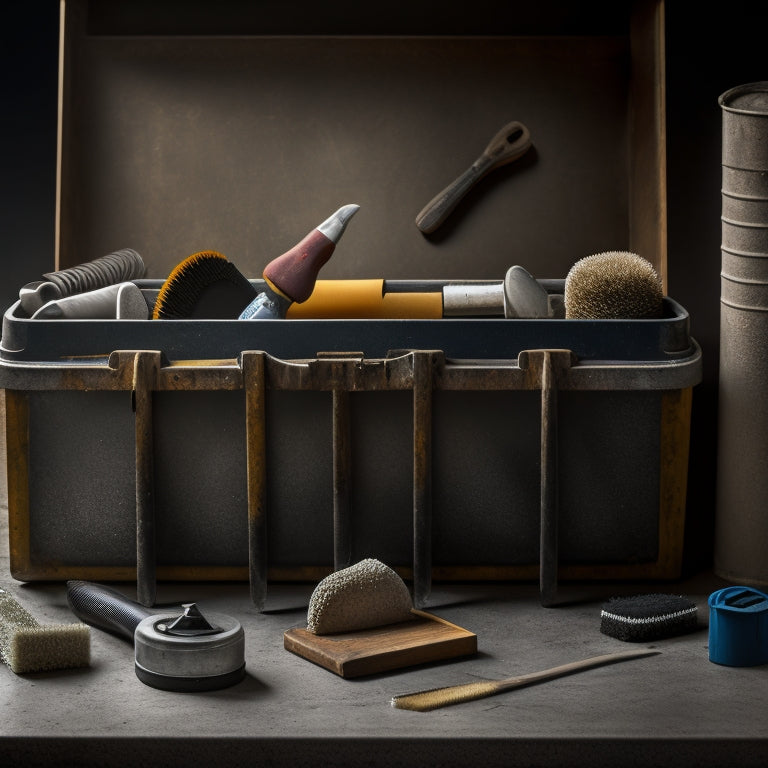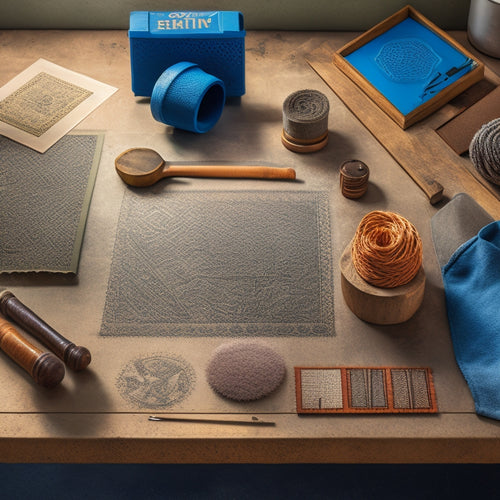
Surface Prep Tools for Concrete Masonry Cleaning
Share
You'll need specialized tools to effectively clean and prepare your concrete masonry for coatings, sealants, and repairs. Wire brushes and chemical cleaners are essential for removing dirt, grime, and old adhesives, while scarifiers, grinders, and sanders help create a surface profile receptive to finishes and repairs. A sturdy scrub brush, reliable pressure washer, and gentle cleaning solutions are also vital for thorough cleaning. By selecting the right tools and techniques, you'll prevent surface damage and guarantee a strong bond between the masonry and finish. Now, discover the best tools and methods to achieve a surface profile that's perfect for your intended treatment.
Key Takeaways
• Specialized tools like wire brushes and chemical cleaners are necessary for effective surface cleaning of cinder blocks without damaging surfaces.
• Scarifiers, grinders, and sanders are used to remove old coatings and laitance, creating a surface profile receptive to finishes and repairs.
• A sturdy scrub brush with stiff bristles and a reliable pressure washer with a wide fan tip are essential for thorough wall coverage and cleaning.
• Gentle cleaning solutions designed for masonry and tough stain removers like masonry detergent or trisodium phosphate (TSP) may be required for effective cleaning.
• Surface profile assessment and moisture testing are critical for strong sealant adhesion and ensuring durable and long-lasting finishes.
Tools for Cinder Block Surface Cleaning
When preparing cinder block surfaces for finishing or repair, you'll need to remove dirt, grime, and old adhesives using specialized tools designed for effective surface cleaning. This vital step in cinder block maintenance guarantees a strong bond between the block and subsequent finishes, such as paint, stucco, or adhesive-backed materials.
A clean surface also allows for ideal surface texture enhancement, which can improve the block's appearance and durability. You'll want to select tools that can efficiently remove contaminants without damaging the block's surface.
Wire brushes, for example, are effective at scrubbing away dirt and grime, while chemical cleaners can help break down old adhesives. Be sure to choose the right tool for the specific cleaning task at hand, as using the wrong tool can lead to surface damage or ineffective cleaning.
Block Surface Preparation Tools
To guarantee a strong bond and ideal results, you'll need to move beyond surface cleaning and use specialized block surface preparation tools to create a surface profile that's receptive to finishes and repairs. This involves more than just cleaning; it's about achieving a surface that's mechanically sound and ready for coatings, paints, or other treatments.
You'll need to employ block finishing techniques that remove imperfections, such as scaling, and create a surface that's free of defects. This might involve using scarifiers, grinders, or sanders to remove old coatings, laitance, or other substances that can interfere with adhesion.
When choosing block surface preparation tools, consider the type of surface treatment options you'll be using. For example, if you'll be applying a waterproofing coating, you may need to use a tool that creates a more aggressive surface profile to guarantee a strong bond.
Cleaning Cinder Block Walls Effectively
You'll need to remove dirt, grime, and other contaminants from cinder block walls before applying finishes or coatings, and that requires a thorough cleaning process. Effective cleaning methods are essential for cinder block maintenance, as they prevent damage and guarantee a strong bond between the block and the finish.
Start by sweeping the walls to remove loose debris. Then, mix a solution of mild detergent and warm water. Use a stiff-bristled brush to scrub the walls, working from the bottom up to prevent streaks. Rinse the walls thoroughly with clean water to remove any soap residue.
For tougher stains, you may need to use a more aggressive cleaning solution or a pressure washer. However, be cautious not to damage the block or dislodge the mortar.
After cleaning, allow the walls to dry completely before applying a finish or coating. By following these steps, you'll guarantee a clean, stable surface that's ready for finishing.
Essential Cinder Block Cleaning Tools
For effective cinder block cleaning, having the right tools at your disposal is crucial, and a sturdy scrub brush with stiff bristles tops the list of essentials. This brush will help remove dirt, grime, and mildew that can compromise the integrity of your cinder block walls.
You'll also need a reliable pressure washer with a wide fan tip to reach all areas of the wall. Set the pressure to a moderate level to avoid damaging the cinder block surface.
Additionally, a gentle cleaning solution specifically designed for masonry surface treatments will help break down dirt and grime without damaging the cinder block. For tough stains, consider using a masonry detergent or a trisodium phosphate (TSP) solution.
Always follow the manufacturer's instructions and take necessary safety precautions when using these products.
Preparing Cinder Block for Sealing
With your cinder block walls thoroughly cleaned, the next step involves evaluating their porosity to confirm a strong bond between the block and the sealant. This critical step guarantees the sealant adheres properly, resulting in a durable and long-lasting finish.
To achieve this, you'll need to assess the block's surface profile, which can be influenced by factors like weathering, efflorescence, or previous surface treatments.
To prepare your cinder block for sealing, consider the following:
-
Profile assessment: Use a surface profiler or a simple scratch test to determine the block's surface roughness and porosity. This will help you choose the most suitable sealing techniques and products.
-
Surface etching: Apply a mild acid etch to the block surface to open up the pores and create a stronger bond with the sealant.
-
Moisture testing: Conduct a moisture test to confirm the block is dry and free of excess moisture, which can compromise the sealant's adhesion.
Frequently Asked Questions
Can I Use a Regular Pressure Washer for Cinder Block Cleaning?
When you're considering cleaning cinder blocks, you might wonder if a regular pressure washer is up to the task.
While it's tempting to use what you have on hand, a regular pressure washer's effectiveness is limited for cinder block maintenance.
The high pressure can damage the surface, causing it to deteriorate faster.
You'll want to opt for a specialized tool that's designed for gentle yet effective cleaning to guarantee your cinder blocks stay in top condition.
How Often Should I Clean My Cinder Block Walls?
Imagine you're the proud owner of a historic cinder block building in downtown Chicago, where grime and soot constantly threaten to tarnish its charm.
To maintain its beauty, you need to determine how often to clean your cinder block walls.
The ideal cleaning frequency depends on environmental factors, but as a general rule, you should establish a regular maintenance schedule, cleaning every 6-12 months, or more often if you notice heavy staining or dirt buildup.
Are All Surface Prep Tools Suitable for New Cinder Block Construction?
When building new cinder block construction, you need to guarantee the surface prep tools you choose are compatible with the fresh material.
Not all tools are suitable, as some can damage the blocks or affect the mortar's adhesion.
You'll want to select tools specifically designed for new construction, taking into account the block's porosity and moisture levels.
Incompatible tools can lead to costly rework, so it's essential to verify tool compatibility before starting your project.
Can I Use Acid-Based Cleaners on Cinder Block Surfaces?
As you venture into the uncharted territory of cinder block surfaces, beware of the acid-based cleaners lurking in the shadows. They may seem like a quick fix, but they'll leave your surface etched and vulnerable to the elements.
Don't let the acid's corrosive power strip away the surface's integrity. Instead, opt for acid neutralization methods that will balance the pH and preserve the surface's strength.
You're in control, so choose wisely.
Do I Need to Wear Protective Gear When Cleaning Cinder Block?
When you're cleaning cinder block, you'll want to prioritize your safety above all else.
You should always wear protective gear, including gloves, safety glasses, and a dust mask, to shield yourself from harsh cleaning agents and debris.
Additionally, adopt proper cleaning techniques, such as working in well-ventilated areas and avoiding harsh scrubbing, to minimize risks.
Conclusion
You've got the grime of ages on your cinder block surface, and it's time to roll up your sleeves and get to work.
With the right surface prep tools, you'll be ready to blast away dirt, grout haze, and old adhesive like a medieval knight slaying dragons.
From wire brushes to chemical cleaners, you've now got the arsenal to prepare your concrete masonry for sealing.
So, gear up and get ready to transform your cinder block walls into a fortress of cleanliness!
Related Posts
-

What Tools Do I Need for Concrete Wall Repair
As you prepare for a concrete wall repair job, you'll need a variety of tools to guarantee a successful outcome. Star...
-

Essential Power Tools for DIY Concrete Sculpting
As you begin DIY concrete sculpting, you'll need a strategic selection of power tools to achieve professional-grade r...
-

5 Best Tools for Stamping Concrete Walls
When it comes to stamping concrete walls, you'll need a range of specialized tools to achieve the desired texture and...


